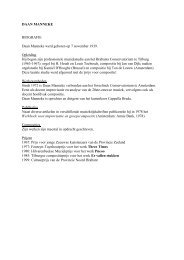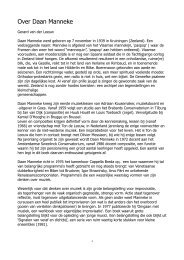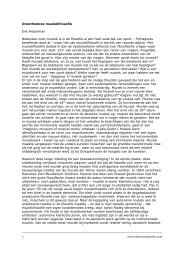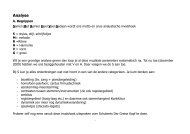Anton Webern and the influence of Heinrich Isaac
Anton Webern and the influence of Heinrich Isaac
Anton Webern and the influence of Heinrich Isaac
You also want an ePaper? Increase the reach of your titles
YUMPU automatically turns print PDFs into web optimized ePapers that Google loves.
<strong>the</strong>se processes, though <strong>Webern</strong> may be creating forms obscure to our perceptual<br />
abilities, he succeeds in creating an essential unity among <strong>the</strong> parts – what’s more, he<br />
succeeds in doing it on an ultimately canonic basis, <strong>the</strong> root <strong>of</strong> which seems to lie in<br />
his study <strong>of</strong> Choralis Constantinus.<br />
Maybe <strong>the</strong>re is an analogy here between <strong>Webern</strong>’s creation <strong>of</strong> unity through<br />
obscured-canonic techniques <strong>and</strong> his observation that<br />
What is wonderful is precisely how <strong>Heinrich</strong> <strong>Isaac</strong> grasps with <strong>the</strong> greatest<br />
insight <strong>the</strong> spirit <strong>of</strong> <strong>the</strong> chant, <strong>and</strong> so absorbs it into himself that <strong>the</strong> chant<br />
appears in <strong>the</strong> master’s music not as something foreign to its nature but<br />
welded into <strong>the</strong> highest unity with it. (<strong>Webern</strong>, 1958: 25)<br />
Though <strong>Webern</strong> didn’t assimilate alien music into his compositions, he never<strong>the</strong>less<br />
employed his technical pr<strong>of</strong>iciency to weld <strong>the</strong> basic materials <strong>of</strong> his pieces into to <strong>the</strong><br />
highest unity with <strong>the</strong> overall structure, just as <strong>Isaac</strong> did with his chant. Yet beyond<br />
this, it seems that <strong>Webern</strong> sought to transcend in his own music <strong>the</strong> unity in that he<br />
perceived in <strong>Isaac</strong>’s. Commenting on <strong>the</strong> fourth movement <strong>of</strong> <strong>the</strong> Cantata II Op. 31<br />
<strong>Webern</strong> has said that ‘this section is constructed in a way that perhaps none <strong>of</strong> <strong>the</strong><br />
‘Ne<strong>the</strong>rl<strong>and</strong>ers’ ever thought up; it was probably <strong>the</strong> hardest task (in that respect) that<br />
I’ve ever had to fulfil!’ (Bailey, 1991: 120). His almost competitive comparison<br />
highlights a constant awareness <strong>of</strong> <strong>the</strong> compositional presence <strong>and</strong> stature <strong>of</strong> <strong>the</strong><br />
‘Ne<strong>the</strong>rl<strong>and</strong>ers’ in <strong>Webern</strong>’s mind, which by <strong>the</strong> time <strong>of</strong> <strong>the</strong> Cantata II was having its<br />
most pr<strong>of</strong>ound effect on his music.<br />
Perhaps <strong>the</strong>n, it is fitting that <strong>the</strong> final movement <strong>of</strong> <strong>Webern</strong>’s final work<br />
should even look like a Ne<strong>the</strong>rl<strong>and</strong>ish score. In it he returns from <strong>the</strong> complex<br />
obscured-canons that appeared earlier in <strong>the</strong> work, to a style <strong>of</strong> relative simplicity, in<br />
which a linear four-part canonic texture is maintained throughout <strong>and</strong> in which <strong>the</strong><br />
15





![Schubert, Winterreise: Einsamkeit [PDF] - bestmusicteacher.com](https://img.yumpu.com/21166489/1/190x135/schubert-winterreise-einsamkeit-pdf-bestmusicteachercom.jpg?quality=85)

![Schubert, Winterreise: Die Nebensonnen [PDF] - Bestmusicteacher ...](https://img.yumpu.com/20295219/1/190x135/schubert-winterreise-die-nebensonnen-pdf-bestmusicteacher-.jpg?quality=85)
